Lao Green papaya salad recipe (Tam Mak Hoong) is an extremely flavorful, mouthwatering salad made from shredded green papaya, tomatoes, beans, and carrots. This crunchy salad is lightly pounded with garlic, Thai chilies, tomatoes, and green beans, then seasoned with pungent fermented sauces, making this recipe one of the raved-about salads in Southeast Asia.

Learn how to cut green papaya using this helpful guide. Also, check out another version of Thai papaya salad here, Thai green bean salad, and spicy cucumber salad here. Use your green papaya in this easy papaya curry here.
Jump to:
- The Origin of Tum Mak Hoong
- Why This Recipe Works
- What Is the Lao green papaya salad recipe, Tam Mak Hoong
- The names and spellings of this classic Lao
- What Goes Into making this Lao papaya salad?
- Optional ingredients for Laos Salad
- The traditional way of shredding green papayas
- How to shred a green papaya with a sharp knife
- How To Make the Best Lao papaya salad
- Optional garnishing or accompaniments
- Helpful Kitchen Notes
- Tips on the Pickled Crab
- Helpful Kitchen Tools for this Recipe
- FAQs
- Related Thai Dishes You’ll Love!
- Lao green papaya salad recipe (Tam Mak Hoong)
The Origin of Tum Mak Hoong
This popular spicy salad comes from Laotian cuisine, where the original recipe was birthed and has been adopted and loved by many worldwide. You can find a lighter and simpler Thai green papaya salad version here.
Try the Lao cucumber salad and Thai green bean salad. Both are delicious street food!
This version of the Lao Papaya salad recipe has many strong and unique flavors. If you are not used to all these new ingredients, be warned you may need some time to get used to the smell and taste. Most especially the smell.
But once you taste the salad, you'll understand what the rave is about! (:
Why This Recipe Works
- This is legit street food at its finest. If you want the real deal, this is it! Pungent, murky, sassy, and full of explosive flavors.
- All ingredients can be found in one place at your local Asian grocery stores.
- Most of the ingredients can be reused for other Thai recipes as well. Check the bottom of the post for related recipes using these ingredients, so you won’t waste them.
- It’s low in carbs, light, and refreshing.
- The flavors are lighting jolt delicious. You will be craving it every week.
- Eating raw vegetables is good for you. This salad is healthy minus the use of sugar. You can substitute honey. I often use agave instead.
- You will impress not only your Western guests with this dish but also your Asian and international friends with such know-how of true Isaan, Lao, and Thai street food.
What Is the Lao green papaya salad recipe, Tam Mak Hoong
Lao papaya salad is a raw salad made from green papaya with garlic, chilis, tomatoes, and green beans and pounded in a clay and mortar pestle. The flavors are seasoned with fish sauce, lime juice, tamarind paste, and sugar.
The extra pungent smell and flavors come from the fermented fish sauce, crab paste, shrimp paste, and pickled whole blue crab. The taste is out of this world, delicious, and super addicting!
It is the best salad in the world!
There are a lot of strong and perhaps unusual ingredients in this recipe. But these are the legit, authentic, true street style ingredients used almost secretly sometimes by locals.
I know because I have seen, smelled, eaten, and inhaled this salad hundreds of times in Thailand, on the streets of Luang Prabang in Laos, and in my home province in Isaan.
Trust me on this one. (;
The names and spellings of this classic Lao
There are many names for this Lao salad. In Lao, people call it Tum Mark Hoong, Tum Som, Tam Lao, and Som Tum Lao. In Thai, it's called, Som Tum, Tum Malakoh (Pounded Papaya) or Som Tum Thai.
What Goes Into making this Lao papaya salad?
These are the main ingredients in Lao papaya salad. Mix and match these items and play around with the portions as needed.
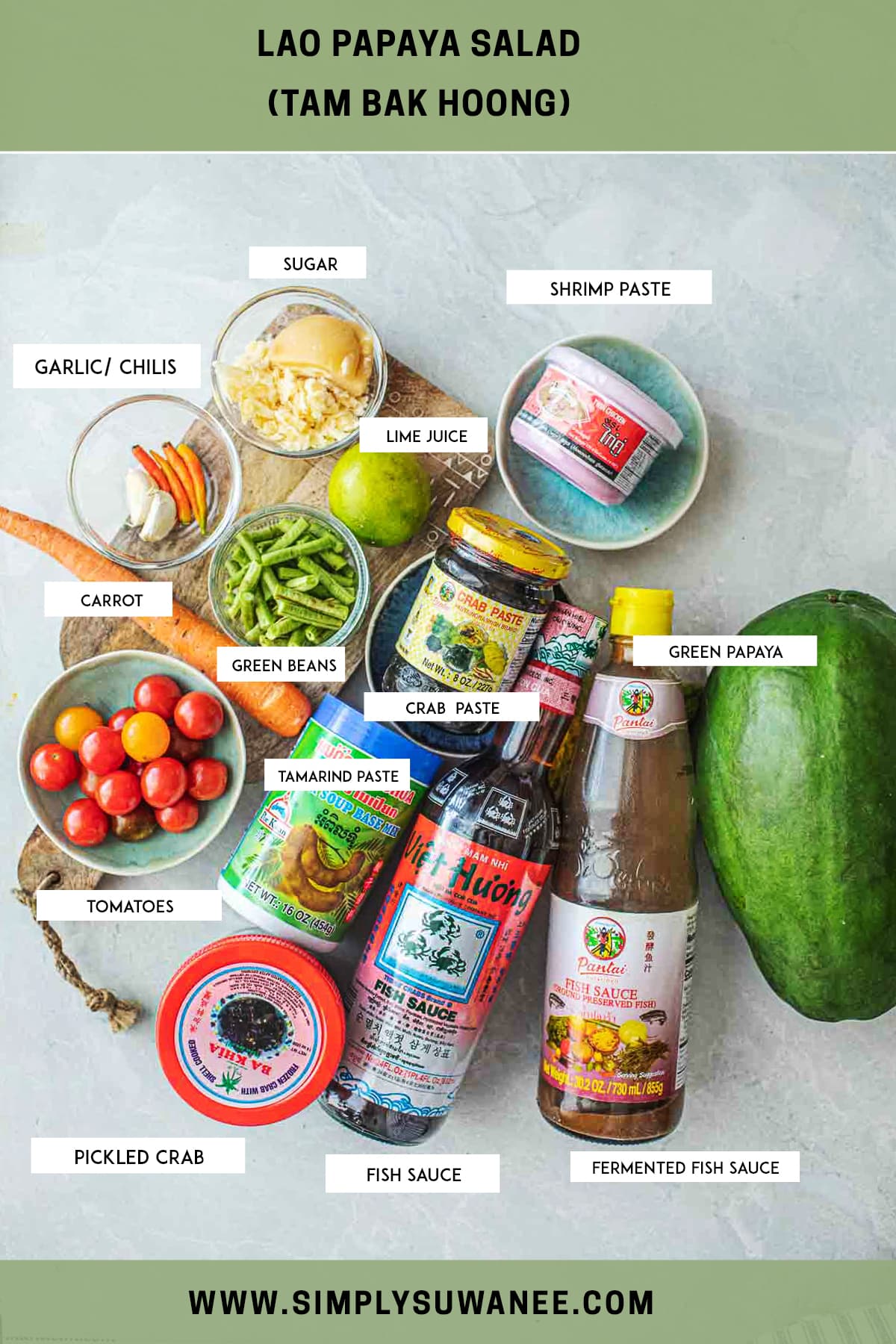
- Green papaya salad. Use only unripe green papaya for this. Never use ripe or orange papaya. The flavors and crunchy texture will not be there.
- Garlic. Use whole garlic cloves rather than paste or minced for the best flavors.
- Thai chilis. Use fresh chilis, and adjust as needed for your taste buds for spice level.
- Tomatoes. Cherry tomatoes yield the most juice and flavors, but any tomatoes are great.
- Green beans. Long green or snake beans are traditionally used, but you can use any available beans.
- Shredded Carrots. Use store-bought shredded carrots or peel your own into thin shreds with a vegetable peeler.
- Pla Ra. Fermented fish sauce is not the same as fish sauce. This is the one sauce I don't recommend you skip out on. It's what gives this salad its iconic taste and smell. Read more about Thai sauce here.
- Shrimp paste. Remove the top waxy part on top of the jar before use. This is not edible. It is used for sealing the container for a longer shelf life.
- Crab paste. Comes in a jar usually. The dark paste gives the salad its murky look but tastes amazing.
- Pickled whole crab. Usually found in the refrigerated section in the Asian market.
- Lime juice. Use fresh lime and save a slice of lime rind to add to the salad for the extra release of bitterness.
- Tamarind. Use tamarind concentrate. Read more about Thai sauces here.
- Fish sauce. This recipe uses a lighter and sweeter fish sauce like three crabs or red boat brands.
- Sugar. Use palm, white, or brown sugar. Agave or honey is excellent for this recipe, too.
Optional ingredients for Laos Salad
For different variations, you can customize your Lao papaya salad with these ingredients if preferred. Thai eggplants, dried shrimp, steamed, boiled, or blanched shrimp, fermented vermicelli rice, and ramen noodles.
These Asian meatballs add extra umami flavors, fish, pork, beef, or chicken meatballs, fish or shrimp cakes,
The traditional way of shredding green papayas
The traditional way of shredding raw green papaya is with a heavy knife rather than a peeler. This method is quite dangerous as you are taking a risk with a sharp knife slipping and cutting your hand or fingers while holding the papaya.
This method of cutting the papayas is twofold. One, the papaya slices are larger and more firm, which helps with the crunchy texture of the finished salad.
Two, in the old days, there were no peelers, and using a knife was the only option Thai cooks had.
I recommend using Kiwi Peeler if you are new to making Som Tum.
How to shred a green papaya with a sharp knife
Read detailed step-by-step instructions on how to cut papaya here.
Hold the papaya with one hand and a knife in the other. Using a sharp and sturdy knife, start shredding the papaya with the knife in one hand while holding the papaya in the other.
Chop the papaya up and down until you have patterns of long cuts in the papaya. Slice the chopped pieces off until you have enough papaya for the salad. Put the rest of the papaya in the fridge for another salad tomorrow. (:
Note that your second shredding method will yield a thicker and crispier papaya salad than the shredding method.
Both are great. It’s only a personal preference.
How To Make the Best Lao papaya salad
Let's start with this classic recipe, a staple food for so many around the globe! There are many ways to make this salad, but this Lao recipe is what I love making with the ingredients found in my local Asian market.
Step 1. Prepare the green papaya. Wash and dry with paper towels, and carefully peel the skin off the papaya with a sharp knife. Peel only the green part, and you will see raw papaya's beautiful white flesh.
Wash the sap off with water and towel dry.


Step 2. Shred the papaya. Use the knife method mentioned above to shred the papaya into thick log slices 4-6 inches long with a Kiwi peeler or grater. Keep shredding until you have about two solid cups.
Make an ice bath for the shredded papaya to keep them fresh and crispy.
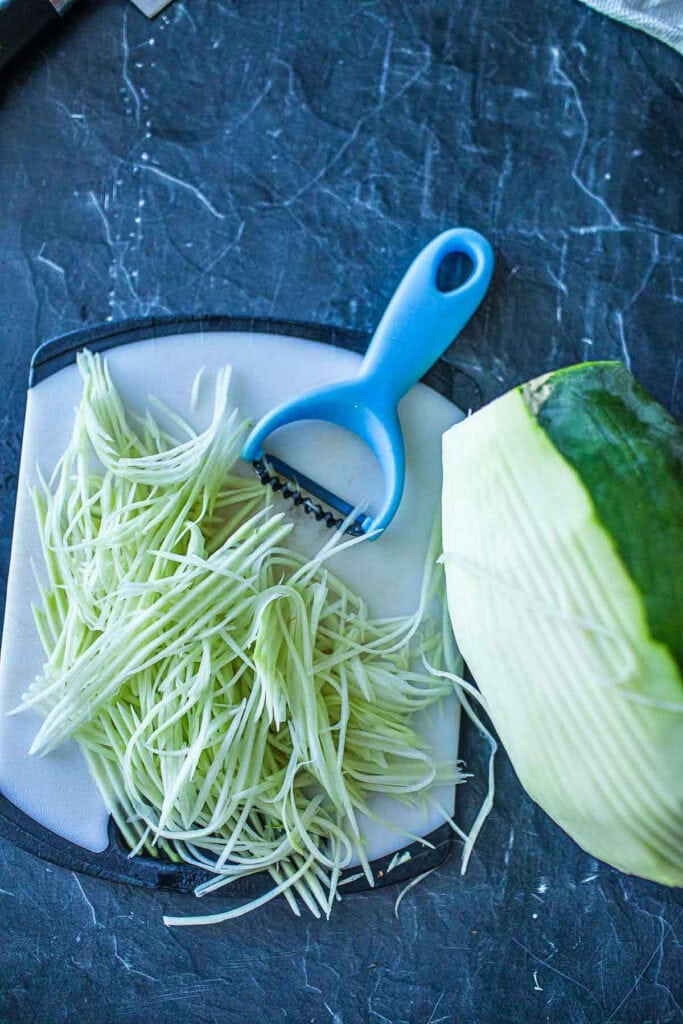

Step 3. Roughly pound garlic and Thai chilies in a large mortar and pestle with a wooden pestle. Don’t make a paste.
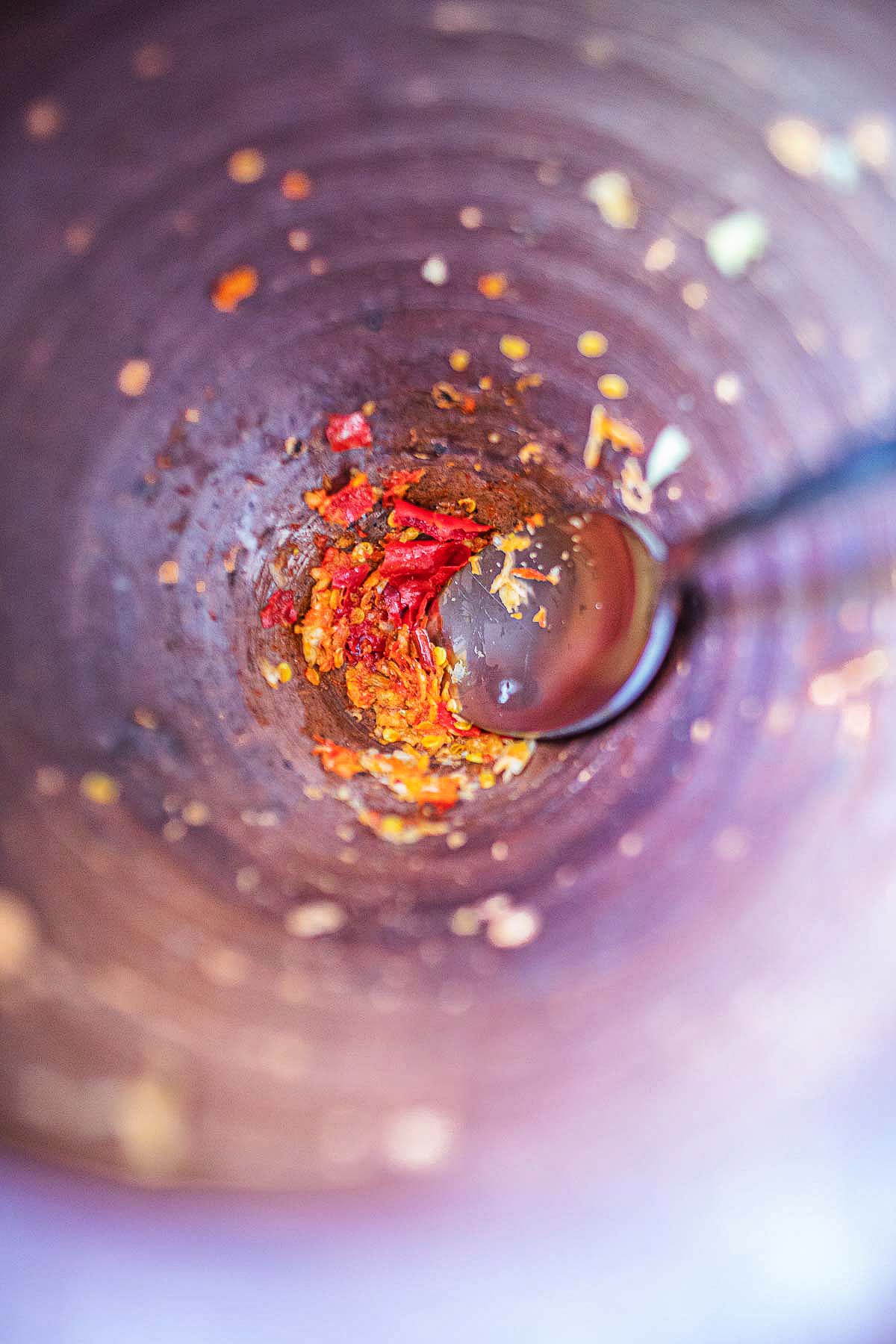
Step 4. Add the green beans and roughly pound them with the wooden pestle, just enough to bruise them. This is where you can add one or two Thai eggplants.

Step 5. Add the sliced tomatoes, pound just enough to bruise, and extract the juice.
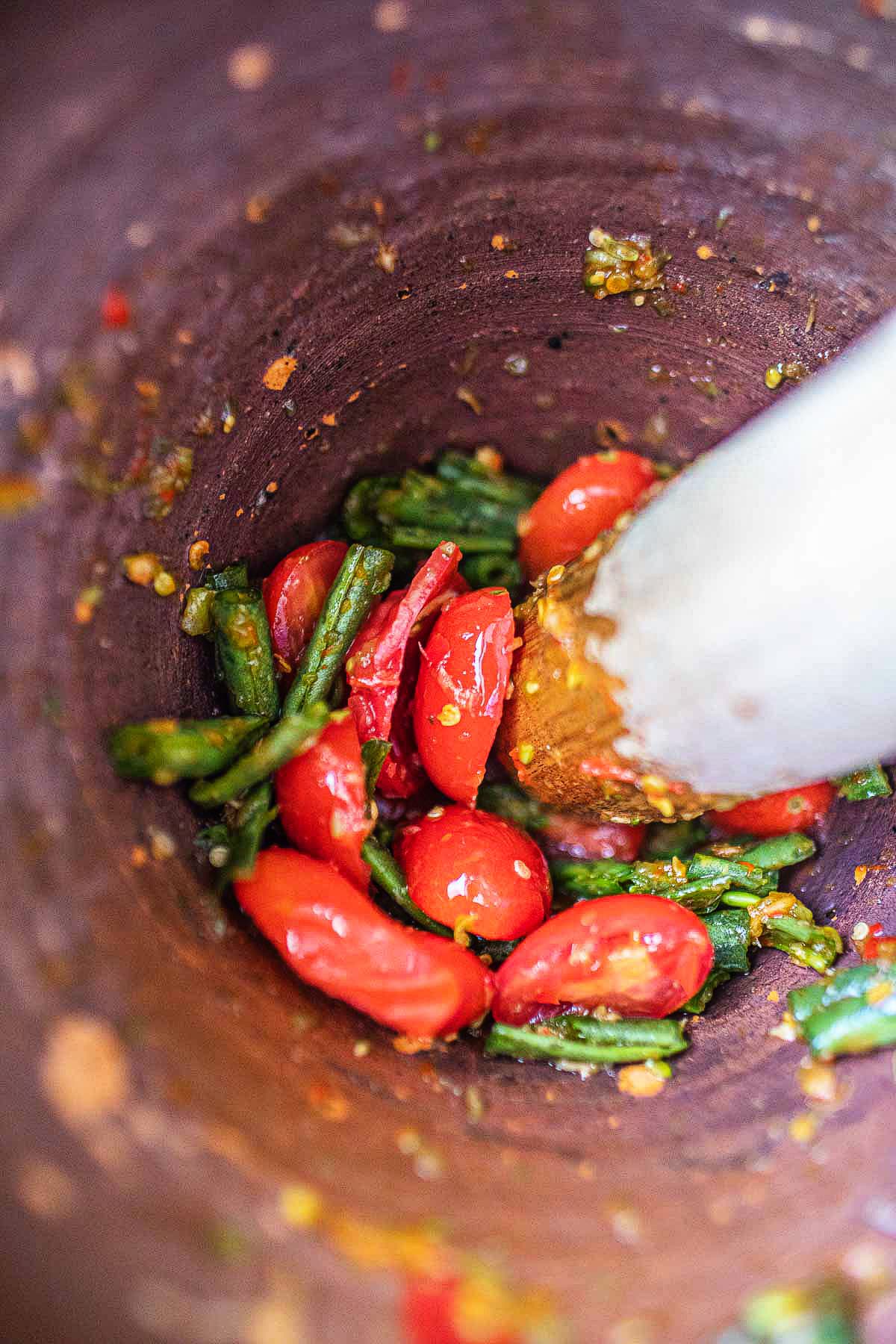
Step 6. Add shrimp paste, crab paste, fermented fish sauce (Pa Daek), pickled crab, fish sauce, and lime juice with rind, tamarind, and sugar.
Leave the rind of the lime, but don’t eat it when served.
Either remove it before serving or set it on the side of a plate as the locals would—half mixing, half light ponding, mixing everything together.
Use a large spoon to help swirl the sauce around in a circular motion with one hand while using the wooden pestle on the other.

Step 7. Add the shredded papaya and carrot and the rest of the lime juice. Lightly pound everything all together one last time. 1 Minute more.
Taste your salad and adjust here with more fish sauce, lime juice, or sugar.

Step 8. Prepare a platter with vegetables and garnishing options on the side. Pour the salad from the mortar into the serving platter, and that's it!
Enjoy the taste of heaven on earth! And again tomorrow. (;

Optional garnishing or accompaniments
- Use Thai basil, purple cabbage, sliced cucumbers, green beans or long beans, Thai green eggplant, and peanuts for garnishes.
- For side dishes, these are popular and highly recommended. Pork rinds, sticky rice, chicken wings, grilled meat, fresh vegetables
Helpful Kitchen Notes
- Soaking the shredded papaya, green beans, and carrots in an ice bath will help crisp the vegetables, adding a fresh, crispy texture to the salad.
- Add a small amount of the seasoning ingredients at a time to ensure the flavors aren’t too strong. You can adjust more toward the end.
- If you find the measurements too strong. Add up to ¼ cup of water to the sauce to help dilute some saltiness.
- Have sticky rice, jasmine rice, and vermicelli noodles ready to serve with the salad.
- Lettuce, napa cabbage, or sliced cabbage to eat the salads as a wrap.
- To achieve a well-mixed salad, use a big spoon and a wooden pestle to stir, flip, and circulate the ingredients in the mortar.
Tips on the Pickled Crab
For the crab chunks you don't actually need to pull the meat out of the crab. The crab comes already in chunks when you buy it in the container. As seen in the photo in step 6 of the recipe, you can leave the crab as it is without breaking it further.
To infuse the flavors and sauces from the crab into the papaya salad mixture, simply throw in the big chunks and lightly pound them in the mortar. The juices from the papaya salad will mix with the crab, creating a delicious combo!
When serving, I like to leave the crab chunks in the platter and just pick them out to the side. They are actually full of juices from the papaya salad, which kids and adults enjoy sucking on for fun.
Please note, it's best to NOT eat the crab chunks or the lime rinds. They are tough to chew on. Thai people typically eat around them.
Helpful Kitchen Tools for this Recipe
FAQs
The Thai version of the papaya salad typically uses fewer ingredients and seasoning than Lao Papaya salads.
Thai style tends to be milder and sweeter. Lao Papaya salad is more pungent, spicy, salty, and sour with less sugar than Thai Som Tum.
The Lao version uses more fermented ingredients, which adds an extra depth of flavors, colors, and smell to the salad. Lao salads are called Tum Mak Hoong.
Lao papaya salad or Tam Mak Hoong is full of incredibly delicious flavors that will leave you wanting more with each bite. Each mouthful builds on the last, especially the spiciness.
Lao papaya salad blends salty, sweet, tangy, umami, and pungent in one delicious bite. And it is extremely addicting!
Throughout Thailand, street stall vendors selling papaya salads usually offer many styles or variations of green salads.
When asked for a Lao-style salad, that means Pla Ra (in Thai), Padaek (in Laos), fermented fish, shrimp, or crab paste are added to the salads for extra flavors.
Lao-style salads swing more towards salty and tangy rather than sweet. Peanuts are not usually added to the Lao-style papaya salad either.
Yes. Papayas are full of fiber, vitamins, and many other health benefits. The salad is mostly raw vegetables pounded with fermented seasoning and some sugar.
You can substitute sugar for agave, honey, monk fruit sugar, or other healthier sweetness of choice. It is an extremely healthy dish.
Why is papaya salad so spicy?
Locals in Thailand and Laos love spicy papaya salad. Eating spicy papaya salads has always been a tradition, even from an early age.
The sounds of lips smacking, mouth wheezing, and eye-watering hot are almost a badge of honor when eating this green salad with friends and family.
The spiciness makes one sweat, which helps cool the body off from the smoldering humidity and heat. The spicy characteristic of Lao papaya salad makes it iconic and sassy.
It’s been a myth in Thai culture that it’s best not to eat papaya salad during pregnancy. I believe the salad uses fermented Pa Deak or Pla Ra, a fermented fish deemed unsafe for the fetus.
Also, the raw nature of vegetables made with spicy chili and strong flavors causes heartburn and stomach sensitivities in pregnant women.
Green papaya salad is best eaten in one meal. It loses its freshness and texture if stored in the fridge for the next meal—a salad with many names.
Thai Papaya salad is typically made in a large clay mortar and wooden pestle for the light pounding of raw vegetables. If you don’t have a set, you can use a few things around the house to make this Thai dish.
Method 1. Use a sturdy medium-sized bowl, and with cooking gloves, use your hands and fingers to massage ingredients together. Method two. Use a sturdy gallon zip lock bag lined with a dish towel and meat tenderizer to pound the bag with the ingredients lightly.

Related Thai Dishes You’ll Love!
- Thai papaya salad
- Easy chicken satay recipe
- 5-minute authentic Thai satay sauce
- Thai cucumber salad for satay
- Thai Gai Yang chicken recipe
** Love a recipe you've tried? Please leave a 5-star rating in the recipe card below and/or a review in the comments section further down the page. Or follow me on Facebook, Pinterest, or Instagram! **
Print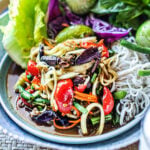
Lao green papaya salad recipe (Tam Mak Hoong)
- Total Time: 30 minutes
- Yield: 8
- Diet: Low Fat
Description
Lao Green papaya salad recipe (Tam Mak Hoong) is a flavorful, mouthwatering salad made from shredded green papaya, tomatoes, beans, and carrots. This crunchy salad is lightly pounded with garlic, Thai chilies, tomatoes, and green beans, then seasoned with pungent fermented sauces making this recipe one of the raved-about salads in Southeast Asia.
Ingredients
- 2 cups shredded green papaya salad.
- 2 large cloves of garlic
- 1-5 fresh Thai chilis, as needed
- ⅔ cup cherry tomatoes, halved
- ½ cup green beans, cut into 1-inch pieces
- ⅓ cup shredded carrots
- 1 tablespoon Pla Ra, fermented fish sauce is not the same as fish sauce
- ½ teaspoon shrimp paste
- ½ teaspoon crab paste
- Pickled whole crab. 1 tablespoon of liquid and ¼ cup of the crab leg pieces.
- 1 ½ teaspoons fresh lime juice. Add one slice of squeezed lime rind to release oil and a slightly bitter taste.
- 1 tablespoon tamarind concentrate
- ½ tablespoon fish sauce.
- 2-3 tablespoon sugar. Add more towards the end of the salad is too spicy.
Instructions
- Prepare the green papaya. Wash, dry with paper towels, and carefully peel the skin off the papaya with a sharp knife. Peeling only the green part, you will see raw papaya's beautiful white flesh. Wash the sap off with water and towel dry.
- Shred the papaya. Use the knife method mentioned above to shred the papaya into thick log slices 4-6 inches long with a Kiwi peeler or grater. Keep shredding until you have about two solid cups. Make an ice bath for the shredded papaya to keep them fresh and crispy.
- Roughly pound garlic and Thai chilies in a large mortar and pestle with a wooden pestle. Don’t make a paste.
- Add the green beans and roughly pound them with the wooden pestle, just enough to bruise them. This is where you can add one or two Thai eggplants.
- Add the sliced tomatoes, pound just enough to bruise, and extract the juice.
- Add shrimp paste, crab paste, fermented fish sauce (Pa Daek), pickled crab, fish sauce, and lime juice with rind, tamarind, and sugar. Leave the rind of the lime, but don’t eat it when served. Either remove it before serving or set it on the side of a plate as the locals would. Half mixing, half light pouring of everything together. Use a large spoon to help swirl the sauce around in a circular motion with one hand while using the wooden pestle on the other.
- Add the shredded papaya and carrot and the rest of the lime juice. Lightly pound everything all together one last time. 1 Minute more. Taste your salad and adjust here with more fish sauce, lime juice, or sugar.
- Prepare a platter with vegetables and garnishing options on the side. Pour the salad from the mortar into the serving platter, and that's it! Enjoy the taste of heaven on earth! And again tomorrow. (;
Notes
- Soaking the shredded papaya, green beans, and carrots in an ice bath will help crisp the vegetables, adding a fresh crispy texture to the salad.
- Add a small amount at a time of the seasoning ingredients to ensure the flavors aren’t too intense. You can adjust more toward the end.
- If you find the measurements too strong, you can add up to ¼ cup of water to the sauce to help dilute some of the saltiness.
- Have sticky rice, jasmine rice, and vermicelli noodles ready to serve with the salad.
- Lettuce, napa cabbage, or sliced cabbage to eat the salads as a wrap.
- Use a large spoon alongside the wooden pestle to help stir, flip, and circulate the salad in the mortar for an even pouring and blending of the sauce into the ingredients.
** Thank you so much for visiting my blog! This is truly a passion for me. If you have enjoyed these recipes and appreciate the hard work I put into them, I would love it if you would share them with your friends! Your recommendation is the highest review I could hope for, and I’d appreciate it! **
- Prep Time: 20
- Cook Time: 10
- Category: salad
- Method: salad
- Cuisine: thai



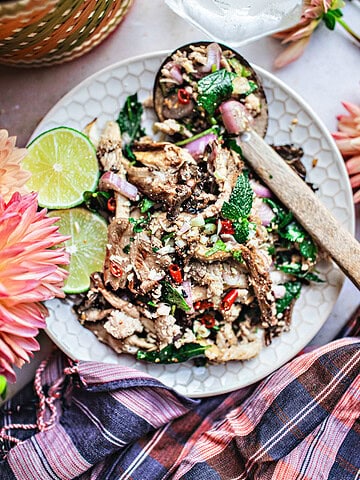
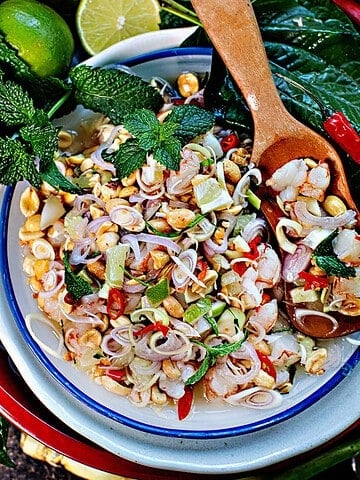
Suwanee says
Hey Veronika!
I leave them in chunks and you don't actually need to pull the meat out of the crab. The crab comes already in chunks when you buy it in the container. So, in step 6 of the recipe, you can leave the crab as it is without breaking it further.
To infuse the flavors and sauces from the crab into the papaya salad mixture, simply throw in the big chunks and lightly pound them in the mortar. The juices from the papaya salad will mix with the crab, creating a delicious combo!
When serving, I like to leave the crab chunks in the platter and just pick them out to the side. They are actually full of juices from the papaya salad, which kids and adults enjoy sucking on for fun. Just a small note, it's best not to eat the crab chunks or the lime rinds as Thai people typically eat around them.
Hope this helps! Let me know if you have any other questions
Veronika says
Hello, I’m so excited to try this heavenly sounding recipe! My one question is-can you go into a little more detail about exactly what you’re supposed to do with the pickled crab? I’ve never worked with it before. Sorry if this is a stupid question but I assume you take the meat out of the shell? Or does it soften? Im very familiar with pickled herring and with those the bones soften and are totally edible and traditionally eaten with the fish, so I’m wondering if it’s the same with pickled crab shells? Or do you just pull the meat out and discard the shell? And how small should you break it up, traditionally? Looking forward to your answer-thank you!
Suwanee says
Thanks so much!
Suwanee says
Thank you so much, Wilma, so glad you love it so much too. I can live off of this too!
Suwanee says
Hi Andrea,
A couple of things. I like my papaya strips large and crispy. First I make sure the papaya is extra firm by keeping it in the fridge until ready to use. If the papaya is not as firm or crispy, I put it in an ice bath to firm it up while preparing the other ingredients. When I use my Kiwi peeler, I really put a lot of pressure on the peeling to get thick strips that stick together. Using a large papaya with a lot of surface helps with getting the bigger strips too. When I pound the papaya together, the strips usually come apart into smaller pieces, (not crushed). So hopefully all this helps with your question? Let me know if I can help answer further. -Suwanee
Wilma Astudillo says
This is the most amazing healthy dish I've ever tried! Suwanee you deserve a 101 stars if not more! I can eat this everyday & never get tired! 💕
Andrea says
I have that same exact peeler-shredder by kiwi made in Thailand. How do you go from the photo where it makes strips of papaya that are stuck together (4-5 strips) to the photo of single strips?? Is there a secret to using the kiwi peeler? Or do people just not mind the stuck together pieces? I don't like how they stick. I use an oxo peeler-shredder that makes nicer separated strips but it's not as fast as the kiwi. What's the secret?
Ashley Stoll says
Fully worth going out to get these special ingredients! The ice bath is such a good idea to keep the veggies crisp. Thank you!
Suwanee says
Thank you so much, Zen!
Suwanee says
Kop khan Ka, Ned! (Thank you) (:
Ned says
Nothing left out. You aim for perfection.
Zen says
The best among other papaya salad recipes. 5 stars